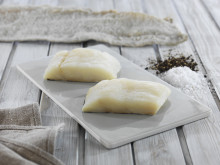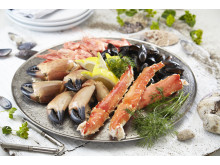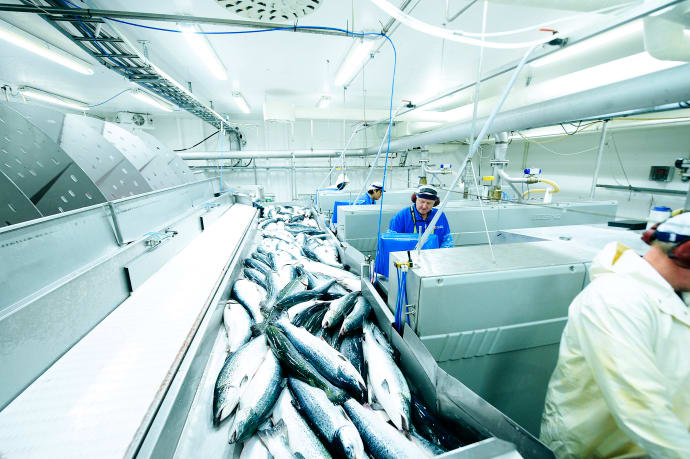Exports of frozen seafood from Norway have risen in recent months, due partly to greater consumption of fishery products at home combined with reduced capacity for shipping fresh products by air. Meanwhile, demand for salmon is rising again in the China market as the nation begins experiencing “gradual normalization” after months of negative economic and social impact from the deadly novel coronavirus (SARS-CoV-2) outbreak in Wuhan late last year that has since become a pandemic infecting more than 2,570,000 people with the Covid-19 respiratory disease and killing over 178,000 worldwide as of April 22.
“Because a number of countries have introduced restrictions [such as lockdowns and physical distancing] that hit the restaurant segment hard, we see shifts towards increased sales of Norwegian seafood in grocery – especially as packaged and frozen products,” reported Paul T. Aandahl, a seafood analyst at the Norwegian Seafood Council (NSC). “If we compare exports with Easter week last year, we see an increase in salmon and cod exports to processing markets such as Poland and the Netherlands, where the fish is repackaged into consumer products for sale in retail.”
Norway exported 213,000 tons of seafood worth NOK 9.6 billion in March. This was an increase of NOK 392 million, or 4 per cent, compared with March of 2019. In the first quarter, 664,000 tons of fishery products were exported, worth NOK 28.6 billion. The value of Norwegian seafood exports has increased by NOK 2.9 billion, or 11 per cent, against the same period last year.
“In the second half of March, the Covid-19 pandemic made its presence felt in Europe and the United States, leading to major turbulence in these seafood markets. Strict restrictions on exports to the United States and a reduction in air cargo capacity hit fresh seafood particularly hard last month. At the same time, we see that the global restaurant sector is almost completely closed and that the demand for seafood within this sales channel has been sharply reduced. Despite the challenging situation in some of our most important markets, export value has continued to increase as a result of a weakening Norwegian kronor,” said Renate Larsen, the NSC’s chief executive officer.

Despite a challenging market situation and a fall in demand for Norwegian seafood, there are some bright points:
- Gradual normalization trends in South Korea as well as China.
- An increase in online sales and food delivery services to households.
- Sales of fresh seafood products in South Korea are constantly setting new records, with quarterly figures showing a 9 per cent increase in Norwegian salmon purchases.
- Demand for Norwegian mackerel in Japan is exceptionally good, with a 59 per cent growth in volume in the first quarter.
- Exports of salted fish and clipfish continue their positive trend, especially to Portugal.
“The corona crisis has affected Norwegian seafood products very differently. Products that are exported to many markets have more resilience in such a situation compared to those that depend on a few core markets,” explained Larsen. “The increased sales in online channels that we see in several markets are from low levels, but this also means that many people are trying out these types of services for the first time. Today’s situation can lead to lasting behavioral changes.”
Minister of Fisheries and Seafood Odd Emil Ingebrigtsen praised the Norwegian seafood industry, which has managed to adapt and take on challenges brought by coronavirus threat.
“A formidable effort is being made in to ensure that seafood reaches consumers worldwide,” said Ingebrigtsen. “The corona situation has put the fresh fish market under pressure, and we are seeing a shift towards processed products. It’s great to see that the seafood industry is adapting to market changes so quickly. The industry’s robustness and adaptability are impressive.”

Salmon Charts Growth
Salomon weighed in at 85,800 tons valued at NOK 6.1 billion in March. This was an increase in volume of 4 per cent, while export value rose by NOK 103 million, or 2 per cent, compared with March of 2019.
In the first quarter, 252,000 tons of salmon were exported, worth NOK 18.5 billion. This was an increase in volume of 2 per cent, while the value rose by NOK 1.8 billion, or 11 per cent. The average price for fresh whole salmon in March was NOK 64.98 per kg, compared with NOK 68.72 per kg in March last year.
Measured by value, Poland, the United States and France were the largest buyers of Norwegian salmon last month.
Despite increased logistical challenges and reduced restaurant consumption, the proportion of salmon exports to Asia represented 17 per cent of the total. This is the same proportion as in March of 2019. The relatively strong sales were due to increased domestic consumption of salmon, either in the form of takeaway, in online channels or in the retail trade.

“Reduced demand and logistical challenges as a result of the Covid-19 pandemic have led to large price declines in local currency. Converted into euros, the export price fell by 19 percent in March compared to the same month last year,” said Aandahl.
The Chinese market saw gradually increased demand in March. In week 13, 517 tons of fresh salmon were exported from Norway to the PRC.
“The first quarter figures confirm the trend of a gradual return in demand for fresh products in China, while we also see further good development for frozen products. Overall, Norwegian seafood exports to China have declined by 12 per cent in value and volume this year. This export trend was in line with expected market development, as China is gradually moving towards normalization,” said, Victoria Braathen, the NSC’s fisheries envoy to the PRC.
The United States is a market that is highly dependent on seafood imports, so air traffic restrictions over the last month or more have been dramatic.
“The development of the Covid-19 pandemic has led to a large part of the American restaurant sector closing down. As a consequence of these conditions, exports of fresh whole salmon have more or less stopped completely,” said Egil Ove Sundheim, the NSC’s fisheries envoy to the USA.
Trout Exports Rise
In March, 5,100 tons of trout were exported with a value of NOK 316 million. Volume increased by 46 per cent, while export value rose by NOK 53 million, or 20 per cent, compared with March of 2019. So far this year, 15,600 tons of trout valued at NOK 969 million have been exported. This is an increase in volume of 43 per cent, while value advanced NOK 201 million, or 26 per cent. The USA, Ukraine and Finland were the largest export markets in March.
Herring and Mackerel Exports Up
Herring exports in March hit 32,300 tons valued at NOK 379 million, up 1 per cent in volume and 39 percent in value. So far this year, 105,500 tons of herring have been exported at a total value of NOK 1.1 billion. Volume remains at the same level as during 2019, while value increased by NOK 248 million, or 29 per cent. Egypt, Poland and Belarus were the most important markets for herring in March.
“The average price of herring measured in US dollars in the first quarter has been somewhat higher than the corresponding period last year,” said Chief Analyst Frank Isaksen of the Norwegian Seafood Council.
In March, 20,800 tons of mackerel were exported to the value of NOK 361 million. Volume increased by 59 percent, while value rose NOK 135 million, or 60 percent. In the first quarter, 81,400 tons of mackerel were exported, worth NOK 1.4 billion. This was an increase in volume of 59 per cent, while value advanced by NOK 495 million, or 58 per cent. China, Egypt and Nigeria were the largest buyers of mackerel in March.
“The increase in volume is due to increased quotas and catches. There has been a reduction in the average price measured in US dollars mainly due to the type of mackerel that has been landed. This has also affected which country products are being exported to. We have had some challenges with the logistics of some markets due to the lack of containers,” said Isaksen.

Demand for Norwegian mackerel in Japan is exceptionally good, and the first quarter saw a growth rate of 52 per cent in this market.
The largest commercial houses report record sales of Norwegian mackerel in March. Boneless fillets and light salted mackerel are especially in demand from Japanese buyers.
“Quarterly figures show a 59 per cent increase in volume, which confirms that both local processing and the industry in Norway are working hard to produce mackerel products from domestic raw materials that are selling well at a time when home consumption is increasing” said Gunvar L. Wie, the NSC’s fisheries envoy to Japan and South Korea.

Skrei Exports Decline, But Frozen Cod Rises
In March, 8,300 tons of fresh cod were exported, including skrei, valued at NOK 365 million. This was a 30 per cent reduction in volume, while the value fell by NOK 124 million, or 25 per cent, compared with March of last year.
During the first quarter, exports of 23,200 tons of fresh cod, including skrei, earned NOK 1.1 billion. This amounted to a 7 per cent reduction in volume, while the value increased by NOK 20 million, or 2 per cent. The value of skrei was NOK 82 million, which is a reduction of 18 per cent year-on-year.
Denmark, Spain and the Netherlands were the largest buyers of fresh cod in March.
“The loss of the restaurant segment has hit exports of fresh white fish particularly hard. March is normally the month of the year with the highest exports of fresh, whole cod and cod, but this year export volumes fell below the levels we had in February. Some of this reduction may also be due to lower catches due to bad weather,” said Ingrid Kristine Pettersen, NSC’s whitefish and conventional products analyst. “At the same time, we have never seen better March figures for direct export of fresh whole yeast to Spain.”

“The robust export figures show what a strong position the quality brand skrei has achieved in Spain. This is a result of the fact that we have managed to position Norwegian skrei as a unique cod with a very special quality that can only be purchased in the period of January to April”, said Bjørn-Erik Stabell, NSC’s fisheries envoy to Spain.
In March, 9,800 tons of frozen cod were exported, worth NOK 452 million. This is an increase in volume of 18 per cent, while the value rose by NOK 97 million, or 27 per cent. In the first quarter, 23,300 tons of frozen cod worth NOK 1.1 billion were shipped abroad. There is a 7 per cent reduction in volume, while the value increased by NOK 23 million, or 2 per cent. China, the United Kingdom and Lithuania were the largest buyers of frozen cod in March.
“After a somewhat sluggish start to the year, there has been significant growth in exports of frozen, whole cod in March, especially to China and Portugal,” said Pettersen.

Growth for Clipfish
Clipfish exports in March weighed in at 6,200 tons worth NOK 375 million. Volume fell by 3 per cent, while value increased by NOK 90 million, or 31 per cent, over March figures posted the previous year. Portugal, Dominican Republic and Congo Brazzaville were our main markets.
In the first quarter, 22,400 tons of clipfish were exported, worth NOK 1.2 billion. This is a 10 per cent reduction in volume, while the value increased by NOK 109 million, or 10 per cent.
“Codfish in particular contributed to value growth in March, with growth in both volume and value measured in Norwegian kronor,” said Pettersen. “The biggest increase has been to Portugal. Here we see the same trend as in many other markets in March. The closure of restaurants in connection with the corona outbreak has led to a large increase in demand for clipfish in the grocery trade and trends in hoarding. This has led to a significant rise in prices in Norwegian kroner, while prices are relatively stable in euros.”

Prawn Exports Improve, As King Crab Declines
Approximately 1,300 tons of prawns were exported at a value of NOK 103 million in March. This is an increase of 59 per cent, while export value increased by NOK 28 million, or 37 per cent, compared to March of last year.
In the first quarter, 3,000 tons of prawns were exported to generate NOK 246 million in receipts. This represents a 16 per cent reduction in volume, while the value fell by NOK 21 million, or 8 per cent. Sweden, the Netherlands and the UK were the largest markets.
Some 71 tons of king crab were exported at a value of NOK 25 million in March. This amounted to a 23 per cent decrease in volume, while export value fell by NOK 5 million, or 16 per cent.
In the first quarter, 422 tons of king crab exports fetched NOK 142 million. There was an 18 per cent reduction in volume, while value fell by NOK 15 million, or 10 per cent.
South Korea, the Netherlands and Vietnam ranked as the biggest buyers of king crab in March.





